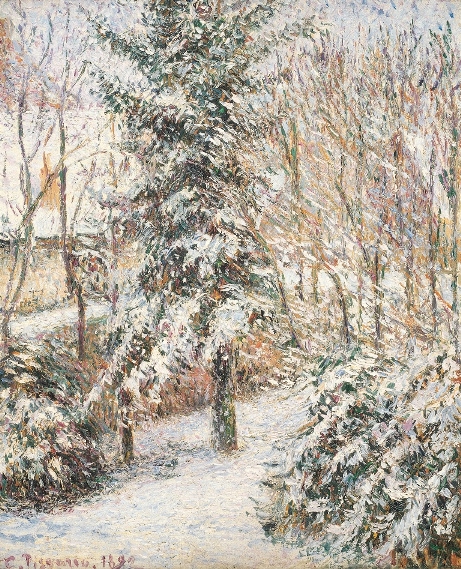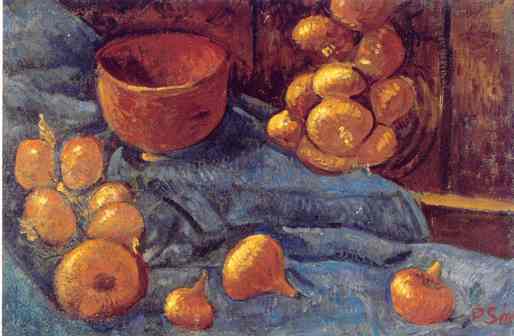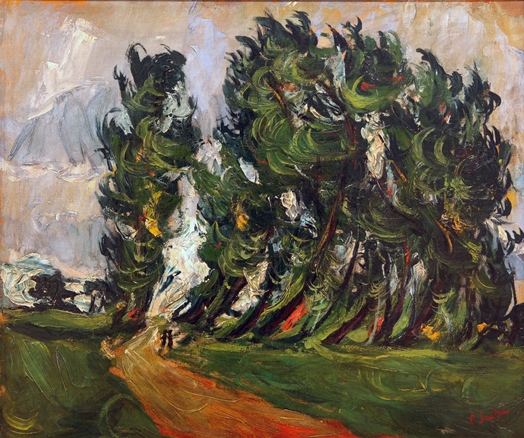An important group in the Hecht Museum's art collection is the work of Jewish painters from the Paris School. The Paris School is a term that distinguishes the French local artists known for the French school as a whole, and the foreign artists who lived and created in Paris during the first three decades of the twentieth century. These artists were drawn to the art capital of the time to study it and experience the local lifestyle that fed the great French art. Many of these artists were Jews, many of whom came from Eastern Europe.
B. St. Thomas, Caribbean Islands, 1830 - d. Paris, 1903
 Pissarro, a French master of Jewish origin, was sent as a young man to study business in Paris, but he was more interested in art and therefore enrolled in the École des Beaux-Arts in 1855. Later, he studied at the Académie Suisse in Paris, where he met Paul Cézanne. Pissarro also took lessons from Camille Corot, who exerted a strong influence on his painting. In 1870, he was in London, where he met Paul Durand-Ruel, who later supported the Impressionists and became Pissarro's patron and dealer.
Pissarro, a French master of Jewish origin, was sent as a young man to study business in Paris, but he was more interested in art and therefore enrolled in the École des Beaux-Arts in 1855. Later, he studied at the Académie Suisse in Paris, where he met Paul Cézanne. Pissarro also took lessons from Camille Corot, who exerted a strong influence on his painting. In 1870, he was in London, where he met Paul Durand-Ruel, who later supported the Impressionists and became Pissarro's patron and dealer.
B. Paris, 1796 - d. Paris, 1875 Ponds in Ville d'Avray, oil on paper mounted on canvas
Ponds in Ville d'Avray, oil on paper mounted on canvas
Jean Baptiste Camille Corot, a 19th century French master of landscape painting, studied under Jean Victor Bertin at the ?cole des Beaux-Arts in Paris. His greatest teacher was, however, nature, particularly Ile-de-France and the surroundings of Paris. On his visits to Italy in the late 1820s, Corot discovered the effects of clear and bright light, but back in France he resumed painting the dawns and twilights of Ille-de-France.
B. Paris, 1863 - d. Finistere, 1927
 Still Life with Onions, 1896, oil on canvas Serusier, a French artist and art theoretician, studied at the Académie Julian in Paris. In 1888, he stayed in Pont-Aven, where he met Gaugin. Back in Paris, he formed the Nabis, a group of artists who combined Symbolist aesthetics with Art Nouveau undulating lines and Impressionist colors. Due to his theoretical inclinations, Sérusier was more conscious of his attitude toward pictorial structure than others in the group.
Still Life with Onions, 1896, oil on canvas Serusier, a French artist and art theoretician, studied at the Académie Julian in Paris. In 1888, he stayed in Pont-Aven, where he met Gaugin. Back in Paris, he formed the Nabis, a group of artists who combined Symbolist aesthetics with Art Nouveau undulating lines and Impressionist colors. Due to his theoretical inclinations, Sérusier was more conscious of his attitude toward pictorial structure than others in the group.
 Portrait of Maud Abrantes, 1908 oil on canvas, Verso of Nude with a HatModigliani was born in Livorno, Italy, into a family of Sephardic Jews who had little money but a rich cultural life. When he arrived in Paris at the age of 22, he had had eight years of academic training behind him, and possessed a great respect for the old masters and a passionate interest in literature, especially poetry. He settled in Montmartre, entered the private Academy of Colorossi, and frequented gatherings of avant-garde artists and poets.
Portrait of Maud Abrantes, 1908 oil on canvas, Verso of Nude with a HatModigliani was born in Livorno, Italy, into a family of Sephardic Jews who had little money but a rich cultural life. When he arrived in Paris at the age of 22, he had had eight years of academic training behind him, and possessed a great respect for the old masters and a passionate interest in literature, especially poetry. He settled in Montmartre, entered the private Academy of Colorossi, and frequented gatherings of avant-garde artists and poets.
B. Smilovichi, near Smolensk, 1893 - d. Paris, 1943
 Path in Forest with Two Children, oil on canvasSoutine, a French painter of Jewish origin, came from an extremely poor family. At the age of 13, he ran away to Minsk, where he took a few drawing lessons. In 1910, he went to study art in Vilna, where he worked for a living in a photography shop. Through the help of a patron, he moved to Paris in 1913, and began to study art under Fernand Cormon at the École des Beaux-Arts.
Path in Forest with Two Children, oil on canvasSoutine, a French painter of Jewish origin, came from an extremely poor family. At the age of 13, he ran away to Minsk, where he took a few drawing lessons. In 1910, he went to study art in Vilna, where he worked for a living in a photography shop. Through the help of a patron, he moved to Paris in 1913, and began to study art under Fernand Cormon at the École des Beaux-Arts.
B. Paris, 1832 - d. Paris, 1883 Head of an old Woman or Woman with a White Head-dress, 1856, oil on canvasÉdouard Manet, a major French master of the 19th century, studied for six years at the École des Beaux Arts in the atelier of Thomas Couture. Manet graduated in 1856. He had a decisive preference for Old Masters and modern life, and gradually introduced modern aesthetics and bold techniques into his paintings. He replaced the tonal gradations of academic practice with vivid contrasts of colors. The Impressionists greatly admired him for his ability to free himself from conventions of literary and moral statements and for his bright colors.
Head of an old Woman or Woman with a White Head-dress, 1856, oil on canvasÉdouard Manet, a major French master of the 19th century, studied for six years at the École des Beaux Arts in the atelier of Thomas Couture. Manet graduated in 1856. He had a decisive preference for Old Masters and modern life, and gradually introduced modern aesthetics and bold techniques into his paintings. He replaced the tonal gradations of academic practice with vivid contrasts of colors. The Impressionists greatly admired him for his ability to free himself from conventions of literary and moral statements and for his bright colors.

